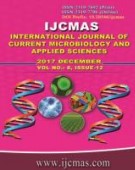


 National Academy of Agricultural Sciences (NAAS)
National Academy of Agricultural Sciences (NAAS)

|
PRINT ISSN : 2319-7692
Online ISSN : 2319-7706 Issues : 12 per year Publisher : Excellent Publishers Email : editorijcmas@gmail.com / submit@ijcmas.com Editor-in-chief: Dr.M.Prakash Index Copernicus ICV 2018: 95.39 NAAS RATING 2020: 5.38 |
The most common infection of the lacrimal apparatus is dacryocystitis. The lacrimal excretory system is prone to infection and inflammation for various reasons. 126 samples from 108 cases (90 unilateral cases + 18 bilateral cases) were collected from clinically diagnosed Dacryocystitis patients attending outpatient department of Sarojini Devi Eye Hospital, Hyderabad. Out of 126 samples 73.15% were culture positive, of which 63.88% were bacterial, 2.77% were fungal and 6.48% were mixed etiology (bacterial+fungal). Gram positive bacteria were predominant, Staphylococcus aureus (34.21%) followed by Staphylococcus epidermidis (28.94%). Among Gram negative bacilli Pseudomonas aeruginosa was predominant (5.26%). Fungi were isolated in 10 cases of which Dematiaceous (n=5) were predominant. Infection was more commonly seen in left eye. Rate of infection was higher in females (59.26%). Higher incidence of infection was seen in the age group of less than 1 year and above 50 years. Gram positive cocci were most susceptible to chloramphenicol (90.9%) and least susceptible to ofloxacin (45.4%). Pseudomonas aeruginosa was equally sensitive to gatifloxacin and moxifloxacin and less sensitive to ceftazidime and gentamicin. The knowledge of bacteriology of dacryocystitis would contribute to the choice of effective antimicrobial agents and would help to reduce the unnecessary load of antimicrobial agents.
 |
 |
 |
 |
 |